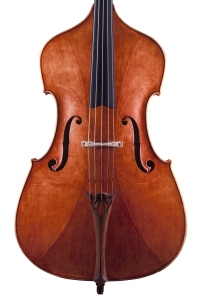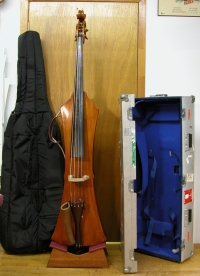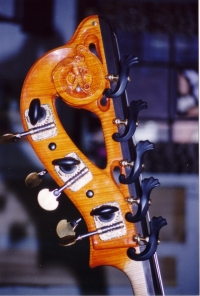Here in short some innovations that Canadian luthier Mario Lamarre has developed at his workshop in Montréal, Québec, for and/or at the request of professional musicians.
Lamarre specializes in making string-quartet instruments as well as double basses (contrabasses). From 1977 to 1980, he studied with Italian master Sylvio de Lellis, who had come to Quebec to found Canada's first stringed-instrument workshop/school. Over the more than 33 years that Lamarre has devoted to exploring the fascinating world of stringed-instrument making, he has developed a very unique approach to his craft, including concepts such as the faceted arch, while continuing to make more traditional instruments. The faceted arch (eight per soundboard, four upper and four lower) is the result of work focusing on the solidity of soundboards and on the quest for a more contemporary design. These facets are shaped like the veins of a maple leaf, with the top of the planes providing the arch with rigidity and flexibility. Positioning these facets allows the violin maker to determine the vibratory characteristics of the arches. The two longitudinal lines of force are oriented according to vibration mode 2 (Chladni pattern developed by acoustician and luthier Carleen Hutchins and her colleagues, http://www.phys.unsw.edu.au/jw/chladni.html). The thickness distribution is approximately the same as that of a classic arch. Lamarre made his first faceted instrument, a violin, in 1984, and has since successfully adapted his facet concept for other string-quartet instruments as well as for the double bass.
What would a musical instrument be without a musician to make it sing? Lajos Molnar, an excellent professional musician who is very knowledgeable about the making of stringed instruments, has been a key source of encouragement for Lamarre since the outset. He immediately recognized the potential of Lamarre's innovative instruments, and having played them for over 30 years, remains completely satisfied with their performance. The sonority created gives the instrument the same tonal and volume characteristics as those produced by a traditional classic arch.
Another of Lamarre's innovations involves the double bass. A huge, generously proportioned instrument measuring over 1.9 metres, the double bass is difficult to transport, making it very costly for classical, jazz and popular musicians who must pay considerable over-baggage charges to travel by airplane to overseas concerts, as well as increasing the risk of damage. That's why since 1995 Lamarre, who is constantly looking for new ways to meet his clients' needs, has been making a semi-acoustic "Lamario" bass with a removable neck, a relatively small instrument that is much easier to transport.
This bass is designed to be amplified, to serve as an acoustic practice instrument and to be dismantled for compact transportation.
The neck is detachable and can be adjusted, as can the height of strings in relation to the fingerboard. The aluminum-rod shoulder is also detachable. The peg box and the scroll are relatively small and it results a lightweight neck. The soundboard is spruce, the ribs cherry plywood and the back cherrywood. The sound holes are located in the ribs. The body has both a bass bar and a sound post. The neck is made from flamed maple and the fingerboard from ebony.
When amplified using a David Gage, Underwood or Full Circle under-bridge pickup, this instrument has the tone, power and balance of a conventional double bass, with excellent sustain and no feedback problems. This small bass can be transported in a cover or case 48 inches long (see cases). It can be disassembled, reassembled and adjusted in five minutes, without any tools whatsoever.
This detachable neck can be adapted for use with all types of standard double basses1, without impacting the sonority of the instrument. Professionally made, custom-fit, reinforced and lined aluminum cases are currently available for the semi-acoustic bass and double bass with removable necks (see cases).
Lamarre told us the following about his innovative removable-neck design: "Over time, I've come to realize that the removable neck creates no adjustment, buzz or solidity problems. Since 1995, I tested this removable neck on a standard double bass with the excellent professional classical musician René Gosselin. Much to our surprise, it made the sonority of the instrument more powerful and more open. Since then I've made more than fifty other removable necks, both for my basses and for older professional classical double basses, and the impact on the sound has been the same, so I attribute this enhancement to fact that the neck can vibrate slightly, independently of the body. This neck is held firmly in place solely by the tension of the strings. Double-bass players now use two or three bridges or insert adjusters at the base of the bridge to compensate for North American climate changes. This neck allows you to adjust the height of the strings and to find the appropriate angle with respect to the bass. With the removable adjustable neck, you can set the string height to within almost a tenth of a millimetre, without reducing the string tension. Another very interesting thing happens to the tension of the strings on the fingerboard. If you use an adjustable bridge, the tension increases when you heighten the strings and decreases when you move them closer to the fingerboard. But with the neck the opposite happens. When the strings are moved further away from the fingerboard the tension decreases and the sound becomes more open, while bringing them closer to the fingerboard increases the tension, promoting the emission of sound."
To meet the need for an extension on a contemporary double bass, Lamarre has developed an extension that is integrated into the sculpted head (traditional scroll and/or one custom-designed for the musician, see photo). This C extension allows a four-string bass to produce the low C or B of a five-string bass. As for a five-string bass with extension, an additional high string, either a C or D, allows the musician to play in the range of the violoncello. It can then be tuned from low B to high D.
Please do not hesitate to send us your comments. They will be very much appreciated.
1. An Internet user directed me to an excellent article about a detachable bass neck made by Franz Prokop at the beginning of the 19th century. Entitled "Bohemian Rhapsody," this article was originally published in Double Bassist, Issue Number 5, Spring 1998 and is available on line at http://www.double bass.co.uk/spring98.htm




